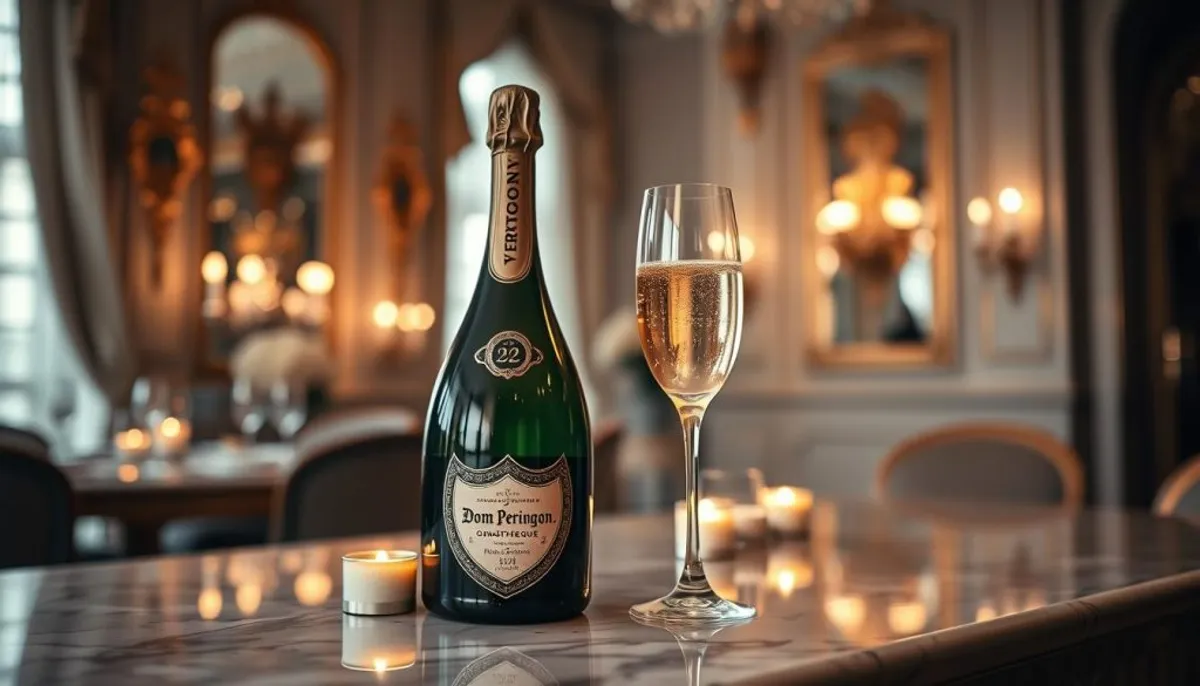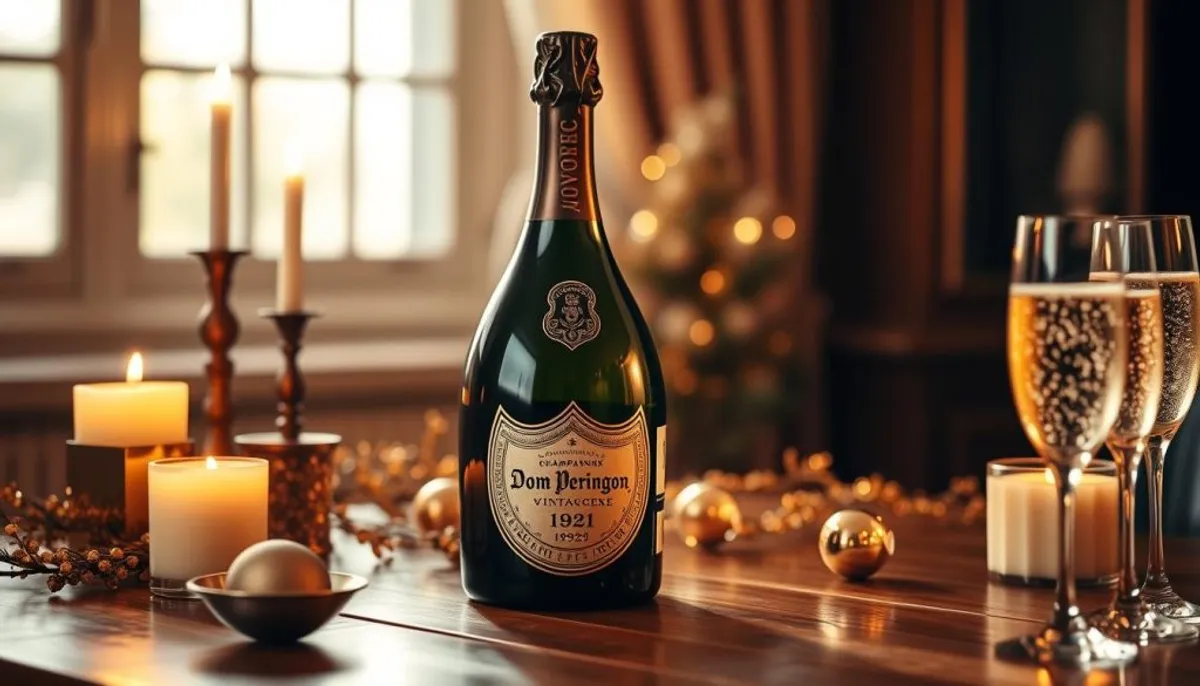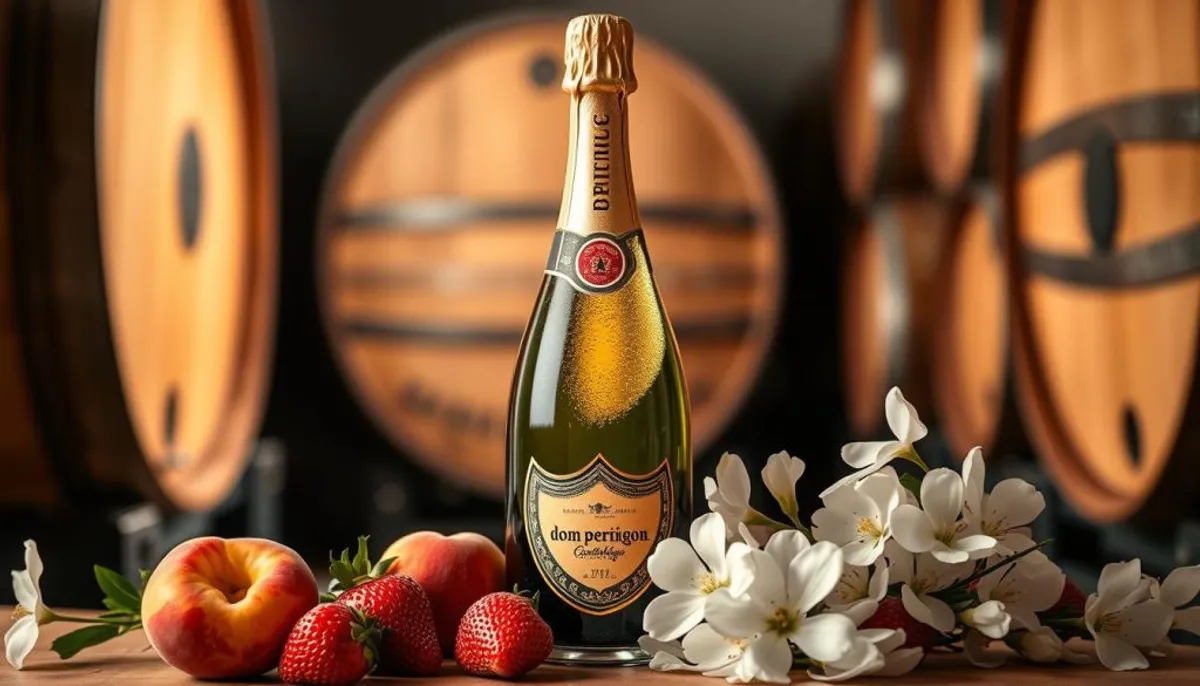Dom Perignon Oenotheque epitomizes the zenith of luxury wine, a prestige cuvée masterfully crafted by Moët & Chandon. Originating from the illustrious Champagne region of France, it offers connoisseurs a glimpse into the realm of exclusivity and perfection. This vintage Champagne is a testament to the brand’s unwavering dedication to excellence.
In 2021, the market for Dom Perignon Oenotheque witnessed a remarkable surge. The 1975 Dom Perignon Brut experienced a 35% price hike, reaching $619. The Oenotheque version of the same vintage skyrocketed to $2,145, reflecting a 15% increase. These figures underscore the escalating demand for this luxury wine.

Dom Perignon Oenotheque has garnered widespread acclaim. Bruce Sanderson awarded the 1975 vintage 97 points, praising its purity and balance. Michael Broadbent described the 1975 Brut as creamy and refined, emphasizing its timeless allure. Such accolades have solidified Dom Perignon Oenotheque’s status as a coveted treasure among wine aficionados and collectors.
Key Takeaways
- Dom Perignon Oenotheque is a prestigious vintage Champagne by Moët & Chandon
- The 1975 vintage saw significant price increases in 2021
- Critics have awarded high scores to Dom Perignon Oenotheque vintages
- The brand’s first vintage dates back to 1921
- Dom Perignon Oenotheque is highly sought after by collectors and wine enthusiasts
The Legacy of Dom Pérignon: Truth Behind the Legend
Dom Pérignon, a name that evokes luxury Champagne, is shrouded in myth and legend. The true role of this Benedictine monk in Champagne history has been a subject of much debate and research.
The Benedictine Monk’s True Contributions
Dom Pierre Pérignon, born around 1638, became the cellarer of Hautvillers Abbey in 1668. For 47 years, he dedicated himself to winemaking, making significant contributions to viticulture and oenology. His innovations included realizing the importance of reducing vineyard yields and blending different grape varieties to improve wine quality.
Debunking Common Myths
Contrary to popular belief, Dom Pérignon did not invent Champagne. This myth originated from Dom Grossard, the last cellar master at Hautvillers Abbey. In reality, Dom Pérignon’s contributions were focused on improving still wine production rather than creating sparkling wine.
Historical Documentation and Evidence
Frère Pierre’s 35-chapter treatise from 1724 documents Dom Pérignon’s achievements in viticulture and winemaking but makes no mention of sparkling Champagne invention. Modern historians and even Moët & Chandon now acknowledge the true extent of Dom Pérignon’s contributions to Champagne production.
| Fact | Detail |
|---|---|
| Birth Year | Circa 1638 |
| Position at Hautvillers Abbey | Cellarer (from 1668) |
| Years in Winemaking | 47 years |
| Key Contributions | Yield reduction, grape blending |
While Dom Pérignon may not have invented Champagne, his winemaking innovations laid the groundwork for the prestigious brand that bears his name today. The first Dom Pérignon Champagne, released in 1936, honored his legacy by setting a new standard for luxury sparkling wines.
Birth of a Prestigious Brand: From Mercier to Moët
The origin of Dom Pérignon exemplifies the pinnacle of luxury wine branding. In 1927, Champagne Mercier held the rights to the Dom Pérignon name but chose not to utilize it. The brand’s destiny was altered by a serendipitous event. Francine Durand-Mercier, the heiress of Champagne Mercier, married Comte Paul Chandon-Moët. This union brought the Dom Pérignon name into the Moët & Chandon family.
The inaugural Dom Pérignon vintage was produced in 1921, preceding its acquisition by Moët & Chandon. This early start underscores the foresight in luxury wine branding that would soon characterize the brand. The onset of the Great Depression in 1927 posed significant hurdles for the sales of premium Champagnes. In response, Moët & Chandon embarked on a bold strategy in luxury wine branding.
Instead of reducing prices, they emphasized the exclusivity and prestige of Dom Pérignon. This approach targeted the British aristocracy, offering a unique luxury cuvée that differentiated itself from other Champagnes. This calculated risk paid dividends, solidifying Dom Pérignon’s reputation as a paragon of luxury.
| Year | Event | Impact |
|---|---|---|
| 1921 | First Dom Pérignon vintage | Set foundation for future brand |
| 1927 | Brand acquisition by Moët & Chandon | Positioned for luxury market |
| 1935 | Official brand launch | Established as luxury Champagne |
Dom Perignon Oenotheque: The Pinnacle of Luxury Champagne
Dom Perignon Oenotheque epitomizes the zenith of luxury Champagne production. It embodies the brand’s unwavering dedication to excellence. This is evident through its late-released vintages and the meticulous extended aging process.
Definition and Significance
Oenotheque is Dom Perignon’s most treasured collection, aged for decades to attain unmatched depth and complexity. Launched in 2000, this series presents vintage Champagnes at their zenith of maturity. It has redefined the benchmark in the realm of fine wines.
Exclusive Production Process
The creation of Oenotheque involves a rigorous selection from Moët & Chandon’s expansive 1,150-hectare estate. Half of these vineyards boast the prestigious Grand Cru classification, guaranteeing access to the finest grapes. This exclusivity is further amplified by collaborations with celebrated artists for special label editions.
Aging Requirements
Oenotheque exemplifies the essence of extended aging in luxury Champagne production. While standard Dom Perignon vintages age for at least eight years, Oenotheque wines undergo significantly longer maturation. The P2 (Plénitude 2) releases, for example, age for 12-15 years, showcasing increased intensity and energy. Some vintages in the Oenotheque range can mature for up to 25-30 years, resulting in wines of unparalleled rarity and sophistication.
| Dom Perignon Range | Minimum Aging Period |
|---|---|
| Standard Vintage | 8 years |
| Rosé | 10 years |
| P2 (Plénitude 2) | 12-15 years |
| Oenotheque (P3) | 20-30 years |
The First Vintage: 1921 and Its Historical Significance
The emergence of Dom Perignon Oenotheque signifies a crucial juncture in Champagne’s history. The 1921 vintage, initially unveiled in 1936, became a foundational element of the luxury wine sector. It established a benchmark for unparalleled quality and rarity.
The Simon Brothers Connection
Anticipating the 1921 vintage’s release, a 1926 vintage was created. Dubbed “Champagne specially shipped for Simon Brothers & Co’s Centenary 1835-1935,” it preceded the official Dom Perignon launch. This early release foreshadowed the excellence that was to follow.

American Market Introduction
In 1936, the American luxury wine market was introduced to Dom Perignon. A consignment of 100 cases of the 1921 vintage arrived in New York, generating excitement among connoisseurs. This event was more than a new product launch; it heralded the inception of the prestige cuvée segment.
The 1921 vintage of Dom Perignon was not merely a new offering. It was a strategic initiative to revitalize Champagne sales amidst the Great Depression. This endeavor was successful, solidifying Dom Perignon’s stature in the luxury wine market and reshaping the vintage Champagne domain.
Terroir and Vineyard Selection
Dom Pérignon’s exquisite Champagne is a testament to the unique Champagne terroir. The brand meticulously selects grapes from a mosaic of vineyards across the region. This ensures each bottle captures the essence of its origins.
Grand Cru Locations
Dom Pérignon sources grapes from several grand cru vineyards, renowned for their exceptional quality. These prestigious locations include Aÿ-Champagne, Ambonnay, Bouzy, Chouilly, Cramant, Mesnil-sur-Oger, and Verzenay. The limestone-rich soils of these grand cru vineyards contribute to the wine’s mineral flavors and enhance drainage.
Premier Cru Sources
Dom Pérignon also utilizes grapes from premier cru vineyards. Notable sources include Cumières, Hautvillers, and Mareuil-sur-Aÿ. These vineyards add depth and complexity to the final blend.
Hautvillers Heritage Vineyards
The Hautvillers heritage vineyards hold a special place in Dom Pérignon’s history. Once belonging to the Abbey where Dom Pérignon himself worked, these vineyards maintain a crucial link to the brand’s origins. Their grapes contribute to the wine’s historical connection and quality.
| Vineyard Classification | Key Locations | Soil Composition |
|---|---|---|
| Grand Cru | Aÿ-Champagne, Ambonnay, Bouzy | 75% Limestone |
| Premier Cru | Cumières, Hautvillers, Mareuil-sur-Aÿ | Limestone-rich |
| Heritage | Hautvillers Abbey Vineyards | Mixed, historically significant |
The careful selection of grapes from these diverse vineyards allows Dom Pérignon to craft Champagnes that truly embody the region’s terroir. This meticulous approach to vineyard selection plays a crucial role in maintaining the brand’s reputation for excellence and consistency.
Master Craftsmanship: The Art of Blending
Dom Pérignon’s excellence is rooted in its mastery of Champagne blending. This technique is fundamental to crafting exceptional vintage Champagnes. The cellar master’s role is pivotal, selecting grapes from various vineyards to achieve a harmonious and complex wine.
Richard Geoffroy, the current cellar master, brings extensive expertise to blending. His ability to merge different grape varieties and vineyard sources imbues each Dom Pérignon vintage with a unique character. This meticulous process ensures every bottle meets the highest standards of quality and taste.
Vintage selection is a critical component of Dom Pérignon’s winemaking. Unlike non-vintage Champagnes, which blend wines from multiple years, Dom Pérignon only produces vintage Champagnes in exceptional years. This commitment to quality means that not every year sees a Dom Pérignon release, making each vintage truly special.
| Aspect | Dom Pérignon Approach |
|---|---|
| Grape Selection | Careful choice from various vineyards |
| Blending Philosophy | Balance between grape varieties and sources |
| Vintage Creation | Only in exceptional years |
| Aging Requirement | Minimum 3 years for vintage Champagne |
The art of blending at Dom Pérignon transcends simple mixing. It’s about orchestrating a symphony of flavors that embodies the essence of a particular year. This commitment to craftsmanship distinguishes Dom Pérignon in the realm of luxury Champagnes.
Vintage Classification and Release Strategy
Dom Pérignon distinguishes itself in the luxury wine market through its vintage Champagne approach. This esteemed house only releases vintage Champagne, meticulously choosing the finest years. Their selection criteria reflect a profound commitment to quality and the art of aging wine.
Declaring Vintages
Dom Pérignon declares vintages only in years that meet their stringent standards. This selective process guarantees that each vintage Champagne embodies the highest quality. The decision to declare a vintage is based on a thorough assessment of the year’s climate and grape quality.
Aging Classifications
The release strategy for Dom Pérignon involves multiple aging stages, allowing for the development of various expressions of the same vintage. This unique method showcases the evolution of their vintage Champagne through extended aging periods.
| Release Stage | Aging Period | Characteristics |
|---|---|---|
| Standard Vintage | 7-10 years | Fresh, vibrant, youthful |
| P2 (Plénitude 2) | 12-15 years | Complex, intense, mature |
| P3 (Plénitude 3) | 20+ years | Refined, ethereal, rare |
This tiered release system allows wine enthusiasts to experience the same vintage at different stages of its life. It highlights the transformative effects of aging on wine. Each stage presents a unique aspect of Dom Pérignon’s craftsmanship, ranging from the fresh vibrancy of the standard vintage to the refined complexity of the P3 release.
Dom Pérignon’s vintage classification and release strategy demonstrate their unwavering commitment to producing exceptional vintage Champagne. By carefully selecting vintages and implementing a staged release approach, they provide wine connoisseurs with the chance to fully appreciate their luxurious creations over time.
Tasting Profile and Characteristics
Dom Perignon Oenotheque presents a tasting profile that captivates connoisseurs. This luxury Champagne is renowned for its complex notes that evolve with each sip.
Aroma Components
The wine aromatics of Dom Perignon Oenotheque are truly exceptional. Delicate floral notes intertwine with ripe fruit scents, creating an intricate bouquet. Mineral undertones add depth, reflecting the unique terroir of the Champagne region.
Palate Structure
The flavor profile of Dom Perignon Oenotheque is characterized by elegance and balance. A fine-grained texture coats the palate, while vibrant acidity provides structure. The finish is notably long, leaving a lasting impression of luxury.

Aging Potential
Dom Perignon Oenotheque boasts remarkable aging potential. These Champagnes can develop gracefully for 30-40 years, gaining complexity and depth over time. The aging process is divided into three stages, known as plenitudes:
- P1: Released after 9 years of aging
- P2: Released after 12-15 years
- P3: Released after about 20 years
Each plenitude offers a unique expression of the vintage, showcasing different aspects of its flavor profile and wine aromatics.
| Plenitude | Aging Period | Characteristics |
|---|---|---|
| P1 | 9 years | Fresh, vibrant, youthful |
| P2 | 12-15 years | Complex, mature, refined |
| P3 | 20+ years | Rich, intense, profound |
Dom Perignon Oenotheque contains 6-7g of residual sugar per liter, slightly sweeter than regular Dom Perignon. This subtle sweetness enhances its flavor profile without overpowering the delicate balance of flavors.
Investment Value and Collection Potential
Dom Pérignon emerges as a top contender for wine investment and rare Champagne collecting. Its esteemed reputation and capacity for aging solidify its status as a luxury wine coveted globally by collectors. Notably, the allure of brands like moet et chandon adds to the competitive landscape of high-end Champagne investment.
Older vintages and Oenotheque releases exhibit remarkable investment potential. The 1993 Dom Perignon P2 Plenitude Brut exemplifies this, with a staggering 1,308% price increase from $346 to $4,870 between November 2021 and April 2023. Even the 2010 Dom Perignon Brut saw a 49% appreciation in less than two years.
Dom Pérignon’s robust investment resilience is evident. Even during the 2008-2009 economic downturn, its average price only dropped by 0.6%. Rare bottles command extraordinary prices at auctions. A 1959 Dom Pérignon Rosé from the Shah of Iran’s collection sold for over $38,000 in 2008.
| Vintage | Price | Special Note |
|---|---|---|
| 1993 P2 Plenitude Brut | $3,247 | Significant price growth |
| 1995 White Gold Brut | $3,425 | Limited edition |
| 1961 Wedding Edition | $9,640 | Rare collectible |
| 2002 Andy Warhol Tribute | $673 | Artistic collaboration |
The Oenotheque series, with its prolonged aging process, presents unparalleled collection potential. Wine critics frequently bestow high scores on these releases, further enhancing their allure to collectors. The 1996 Dom Pérignon Oenotheque, for example, garnered 97 points from multiple respected critics.
Storage and Serving Recommendations
Proper wine storage and Champagne serving techniques are crucial for preserving the exquisite flavors of Dom Pérignon Oenotheque. This luxury vintage Champagne demands special care to maintain its quality and ensure an optimal tasting experience.
Temperature Guidelines
For wine cellaring, maintain a constant cool temperature between 10-12°C (50-54°F). This range is ideal for both storage and serving. Avoid temperature fluctuations, as they can negatively impact the wine’s flavor profile.
Glassware Selection
Choose the right glassware to enhance your Champagne serving experience. White wine glasses or tulip-shaped Champagne flutes are perfect for Dom Pérignon Oenotheque. These shapes concentrate the wine’s aromas and allow proper bubble formation.
Cellaring Conditions
Optimal wine storage conditions are essential for Dom Pérignon Oenotheque. Keep the bottles in a dark, vibration-free environment with high humidity. This protects the wine from light damage and prevents cork drying.
| Storage Factor | Recommended Condition |
|---|---|
| Temperature | 10-12°C (50-54°F) |
| Humidity | 70-80% |
| Light Exposure | Minimal to None |
| Vibration | None |
By following these wine storage and Champagne serving guidelines, you’ll ensure that every bottle of Dom Pérignon Oenotheque reaches its full potential, delivering an unforgettable tasting experience.
Notable Vintage Reviews and Ratings
Dom Pérignon’s Champagne vintages have garnered significant attention from wine critics worldwide. The brand’s commitment to excellence is reflected in the consistently high wine ratings received across various vintages.
Critic Scores
Wine critics have lavished praise on several Dom Pérignon vintages. The 1996 release earned an impressive 98 points from Wine Advocate, while the 2002 vintage secured 98 points from Vinous. These scores underscore the exceptional quality of Dom Pérignon Champagnes.
Vintage Comparisons
When comparing Champagne vintages, Dom Pérignon stands out for its consistency and quality. The 1990, 1996, and 2002 vintages are often cited as standouts. The 2008 vintage, with its perfect 50/50 blend of Chardonnay and Pinot Noir, aims for supreme freshness and longevity.
| Vintage | Score | Notes |
|---|---|---|
| 2009 | 93/100 | Warm and ripe |
| 2004 | 96/100 (potential) | Emerging from grumpy phase |
| 2002 | 96/100 (potential) | Dense, rich, honeyed sweetness |
The 1976 Dom Pérignon Oenotheque Brut Millesime received 95 points from Antonio Galloni, showcasing the longevity of these exceptional Champagnes. With proper storage, the 1976 vintage can be enjoyed until 2032, demonstrating the remarkable aging potential of Dom Pérignon’s finest offerings.
Conclusion
Dom Perignon Oenotheque epitomizes luxury Champagne, merging ancient traditions with modern wine expertise. This iconic brand has built a legacy over decades, providing wine aficionados with access to the finest bubbly expressions. It stands as a testament to the pinnacle of winemaking.
The aging process of Dom Perignon is unparalleled. Unlike vintage Champagnes, which legally require only 3 years of aging, Dom Perignon spends a minimum of 7 years maturing. The P2 (Second Plentitude) release further extends this, with vintages like the 1998 aging for over 21 years. This commitment to time and craftsmanship results in a product that embodies the art of winemaking.
For collectors and connoisseurs, Dom Perignon Oenotheque offers unmatched investment potential. The P2 1998 vintage, priced at $375, exemplifies the value appreciation these bottles can achieve. The upcoming P3 releases, aged for more than 30 years, are expected to command prices above $1,000 per bottle. This solidifies their status in the luxury Champagne market.
In essence, Dom Perignon Oenotheque represents the zenith of Champagne production. Each bottle narrates a tale of terroir, craftsmanship, and time. It invites those who partake to experience the finest that the world of wine has to offer. For enthusiasts and collectors, it remains an unparalleled treasure in the realm of vintage collections and wine expertise.
RelatedRelated articles



